Coxsackievirus mutants that can bypass host factor PI4KIIIβ and the need for high levels of PI4P lipids for replication
- PMID: 22945356
- PMCID: PMC3494396
- DOI: 10.1038/cr.2012.129
Coxsackievirus mutants that can bypass host factor PI4KIIIβ and the need for high levels of PI4P lipids for replication
Abstract
RNA viruses can rapidly mutate and acquire resistance to drugs that directly target viral enzymes, which poses serious problems in a clinical context. Therefore, there is a growing interest in the development of antiviral drugs that target host factors critical for viral replication, since they are unlikely to mutate in response to therapy. We recently demonstrated that phosphatidylinositol-4-kinase IIIβ (PI4KIIIβ) and its product phosphatidylinositol-4-phosphate (PI4P) are essential for replication of enteroviruses, a group of medically important RNA viruses including poliovirus (PV), coxsackievirus, rhinovirus, and enterovirus 71. Here, we show that enviroxime and GW5074 decreased PI4P levels at the Golgi complex by directly inhibiting PI4KIIIβ. Coxsackievirus mutants resistant to these inhibitors harbor single point mutations in the non-structural protein 3A. These 3A mutations did not confer compound-resistance by restoring the activity of PI4KIIIβ in the presence of the compounds. Instead, replication of the mutant viruses no longer depended on PI4KIIIβ, since their replication was insensitive to siRNA-mediated depletion of PI4KIIIβ. The mutant viruses also did not rely on other isoforms of PI4K. Consistently, no high level of PI4P could be detected at the replication sites induced by the mutant viruses in the presence of the compounds. Collectively, these findings indicate that through specific single point mutations in 3A, CVB3 can bypass an essential host factor and lipid for its propagation, which is a new example of RNA viruses acquiring resistance against antiviral compounds, even when they directly target host factors.
Figures
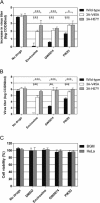
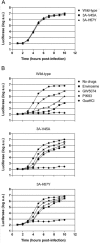
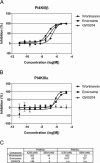
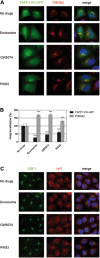
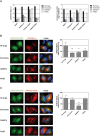
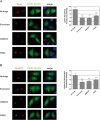

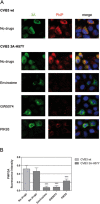
Similar articles
-
Recruitment of PI4KIIIβ to coxsackievirus B3 replication organelles is independent of ACBD3, GBF1, and Arf1.J Virol. 2014 Mar;88(5):2725-36. doi: 10.1128/JVI.03650-13. Epub 2013 Dec 18. J Virol. 2014. PMID: 24352456 Free PMC article.
-
Mutations in the nonstructural protein 3A confer resistance to the novel enterovirus replication inhibitor TTP-8307.Antimicrob Agents Chemother. 2009 May;53(5):1850-7. doi: 10.1128/AAC.00934-08. Epub 2009 Feb 23. Antimicrob Agents Chemother. 2009. PMID: 19237651 Free PMC article.
-
New small-molecule inhibitors effectively blocking picornavirus replication.J Virol. 2014 Oct;88(19):11091-107. doi: 10.1128/JVI.01877-14. Epub 2014 Jul 9. J Virol. 2014. PMID: 25008939 Free PMC article.
-
Phosphoinositides in the hepatitis C virus life cycle.Viruses. 2012 Oct 19;4(10):2340-58. doi: 10.3390/v4102340. Viruses. 2012. PMID: 23202467 Free PMC article. Review.
-
[Exploration for anti-enterovirus compounds and analysis on the mechanism of its inhibitory effect on virus infection].Uirusu. 2013;63(1):93-102. doi: 10.2222/jsv.63.93. Uirusu. 2013. PMID: 24769585 Review. Japanese.
Cited by
-
Initiation of protein-primed picornavirus RNA synthesis.Virus Res. 2015 Aug 3;206:12-26. doi: 10.1016/j.virusres.2014.12.028. Epub 2015 Jan 12. Virus Res. 2015. PMID: 25592245 Free PMC article. Review.
-
Enterovirus Replication Organelles and Inhibitors of Their Formation.Front Microbiol. 2020 Aug 20;11:1817. doi: 10.3389/fmicb.2020.01817. eCollection 2020. Front Microbiol. 2020. PMID: 32973693 Free PMC article. Review.
-
Mutations in VP1 and 3A proteins improve binding and replication of rhinovirus C15 in HeLa-E8 cells.Virology. 2016 Dec;499:350-360. doi: 10.1016/j.virol.2016.09.025. Epub 2016 Oct 13. Virology. 2016. PMID: 27743961 Free PMC article.
-
Phosphatidylinositol 4-kinase III beta is essential for replication of human rhinovirus and its inhibition causes a lethal phenotype in vivo.Antimicrob Agents Chemother. 2013 Jul;57(7):3358-68. doi: 10.1128/AAC.00303-13. Epub 2013 May 6. Antimicrob Agents Chemother. 2013. PMID: 23650168 Free PMC article.
-
A Single Point Mutation in the Rhinovirus 2B Protein Reduces the Requirement for Phosphatidylinositol 4-Kinase Class III Beta in Viral Replication.J Virol. 2018 Nov 12;92(23):e01462-18. doi: 10.1128/JVI.01462-18. Print 2018 Dec 1. J Virol. 2018. PMID: 30209171 Free PMC article.
References
-
- Mallia P, Contoli M, Caramori G, Pandit A, Johnston SL, Papi A. Exacerbations of asthma and chronic obstructive pulmonary disease (COPD): focus on virus induced exacerbations. Curr Pharm Des. 2007;13:73–97. - PubMed
-
- Tebruegge M, Curtis N. Enterovirus infections in neonates. Semin Fetal Neonatal Med. 2009;14:222–227. - PubMed
-
- Whitton JL, Cornell CT, Feuer R. Host and virus determinants of picornavirus pathogenesis and tropism. Nat Rev Microbiol. 2005;3:765–776. - PubMed
-
- Bible JM, Pantelidis P, Chan PK, Tong CY. Genetic evolution of enterovirus 71: epidemiological and pathological implications. Rev Med Virol. 2007;17:371–379. - PubMed
Publication types
MeSH terms
Substances
LinkOut - more resources
Full Text Sources

